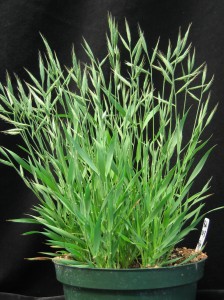Sorry this is late going up. -James
This morning Nature officially published the paper* describing the sequence of the Brachypodium distachyon genome. This publication brings the number of grass genomes available for comparative analysis to four. In celebration I’m going to list four reasons to be excited about the publication of this genome.
The location of Brachypodium within the grass family tree.
Brachy (as I will refer to the species from here on) is a member of the Pooideae a sub-family of grasses from which no sequenced grasses have come. For the work we do in my lab this is exciting because it adds more depth to our analysis of changes in the grass genomes. The more distantly related grasses we can compare at the whole genome level, the better we can infer what the ancestral species that gave rise to all the grasses might have been like at a genome level. The most we know, or can make educated guesses about that species, the better position we are in to say what changed along the evolutionary paths leading to grasses like maize, rice, and sorghum. The choice of the Pooideae wasn’t at random, or even because of the sub-family’s distant relationship to other sequenced grasses. (more…)
